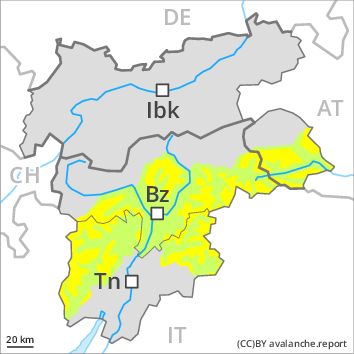Regions
Val Müstair Alps, Western Verwall Mountains, Langtaufers, Eastern Verwall Mountains, Schnals Ridge, Silvretta, Southern Stubai Alps, Samnaun Mountains, Southern Zillertal Alps and High Tauern, Northern Oetz and Stubai Alps, Saldurn-Mastaun Ridge, Western Tuxer Alps, Texel Mountains, Eastern Tuxer Alps, Western Kitzbühel Alps, Western Pfunderer Mountains, Eastern Kitzbühel Alps, Glockturm Range, Eastern Pfunderer Mountains, Durreck Range, Weißkugel Range, Western Rieserferner Mountains, Gurgler Range, Central Stubai Alps, Ortler Range, Northern Zillertal Alps, Allgäu Alps, Venediger Range, Eastern Lechtal Alps - Ammergau Alps, Eastern Rieserferner Mountains, Mieming Mountains, Glockner Range, Karwendel Mountains, Brandenberg Alps, Wilder Kaiser Mountains - Waidring Alps, Western Lechtal Alps, Central Lechtal Alps, Grieskogel Mountains

Danger level
Avalanche Problem
Wind-drifted snow above the treeline, N-NE-E-SE-NW
Wet snow above 2600m, SE-S-SW-W

Fresh wind slabs - warming.
The backcountry and freeriding conditions remain to some extent precarious. As a consequence of a strong to storm force northwesterly wind, extensive wind slabs formed in particular in the regions exposed to heavier precipitation. Wind slabs can in some places be released, even by a single winter sport participant and reach medium size. These avalanche prone locations are covered with fresh snow and are therefore barely recognisable, even to the trained eye. Whumpfing sounds and the formation of shooting cracks when stepping on the snowpack can indicate the danger.
Significant warming to high altitudes: As a consequence of warming, the likelihood of loose snow avalanches being released will increase significantly on very steep sunny slopes. In addition as the day progresses an increasing number of small and, in isolated cases, medium-sized slab avalanches are possible. A latent danger of gliding avalanches exists, in particular on steep sunny slopes below approximately 2500 m.
Snowpack
dp 6: cold, loose snow and wind
The snowpack will be subject to considerable local variations. The fresh snow and wind slabs are lying on soft layers, especially on wind-protected shady slopes above the tree line as well as in areas close to the tree line. In some places relatively hard layers of snow are lying on old snow containing large grains.
Tendency
On Sunday as a consequence of the rain there will be a gradual increase in the danger of wet and gliding avalanches.
